 Database
Database Mysql Tutorial
Mysql Tutorial How to design a reliable MySQL table structure to implement message push function?
How to design a reliable MySQL table structure to implement message push function?
How to design a reliable MySQL table structure to implement message push function?
Overview:
With the popularity of mobile applications, the message push function has become one of the core functions of many applications. When implementing the message push function, it is very important to design a reliable MySQL table structure. This article will introduce how to design a reliable MySQL table structure and provide specific code examples.
Table structure design:
In order to realize the message push function, we can design the following table structures: user table, device table, message table. The following is the specific design of these tables:
-
User table (user):
- id: user ID, primary key
- name: user Name
- email: User email address
- password: User password
- created_at: Creation time
- updated_at: Update time
-
Device table (device):
- id: device ID, primary key
- user_id: user ID, foreign key associated with the id field of the user table
- token: device push token
- created_at: creation time
- updated_at: update time
- ##Message table (message):
- id: message ID, primary key
- sender_id: sender ID, foreign key associated with the id field of the user table
- receiver_id: receiver ID, foreign key associated with the user table The id field
- content: message content
- sent_at: sending time
- is_read: whether it has been read
The following is a code example using the MySQL statement to create the above table:
- User table (user):
CREATE TABLE user ( id INT PRIMARY KEY AUTO_INCREMENT, name VARCHAR(50) NOT NULL, email VARCHAR(100) NOT NULL, password VARCHAR(50) NOT NULL, created_at TIMESTAMP DEFAULT CURRENT_TIMESTAMP, updated_at TIMESTAMP DEFAULT CURRENT_TIMESTAMP ON UPDATE CURRENT_TIMESTAMP );
- Device table (device):
CREATE TABLE device ( id INT PRIMARY KEY AUTO_INCREMENT, user_id INT NOT NULL, token VARCHAR(100) NOT NULL, created_at TIMESTAMP DEFAULT CURRENT_TIMESTAMP, updated_at TIMESTAMP DEFAULT CURRENT_TIMESTAMP ON UPDATE CURRENT_TIMESTAMP, FOREIGN KEY (user_id) REFERENCES user(id) );
- Message table (message):
CREATE TABLE message ( id INT PRIMARY KEY AUTO_INCREMENT, sender_id INT NOT NULL, receiver_id INT NOT NULL, content VARCHAR(255) NOT NULL, sent_at TIMESTAMP DEFAULT CURRENT_TIMESTAMP, is_read BOOLEAN DEFAULT 0, FOREIGN KEY (sender_id) REFERENCES user(id), FOREIGN KEY (receiver_id) REFERENCES user(id) );
When designing a reliable MySQL table structure to implement the message push function, we need to consider the design of the user table, device table and message table. Through appropriate table structure design and foreign key association, we can easily implement the message push function and provide good data management and query functions.
The above is the detailed content of How to design a reliable MySQL table structure to implement message push function?. For more information, please follow other related articles on the PHP Chinese website!
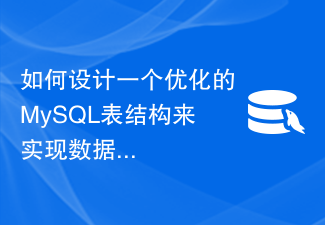 如何设计一个优化的MySQL表结构来实现数据统计功能?Oct 31, 2023 am 11:44 AM
如何设计一个优化的MySQL表结构来实现数据统计功能?Oct 31, 2023 am 11:44 AM如何设计一个优化的MySQL表结构来实现数据统计功能?在实际的软件开发中,数据统计是一个非常常见且重要的功能。而MySQL作为一种常用的关系型数据库管理系统,其表结构设计的优化对于数据统计功能的实现来说尤为重要。本文将介绍如何设计一个优化的MySQL表结构来实现数据统计功能,并且提供具体的代码示例。按需求分析确定表结构在设计MySQL表结构之前,首先需要了解
 如何设计一个可扩展的MySQL表结构来实现商品管理功能?Oct 31, 2023 am 10:06 AM
如何设计一个可扩展的MySQL表结构来实现商品管理功能?Oct 31, 2023 am 10:06 AM如何设计一个可扩展的MySQL表结构来实现商品管理功能?商品管理是许多电商网站和其他在线商店的核心功能之一。为了支持该功能的高效和可扩展性,设计一个合适的MySQL表结构是至关重要的。本文将介绍如何设计一个可扩展的MySQL表结构来实现商品管理功能,并提供具体的代码示例。一、商品主表设计首先,我们需要设计一个商品主表来存储商品的基本信息,如商品名称、价格、库
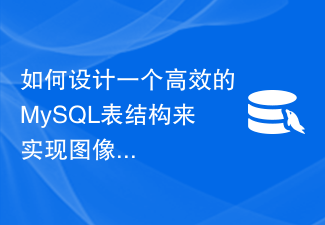 如何设计一个高效的MySQL表结构来实现图像处理功能?Oct 31, 2023 am 11:37 AM
如何设计一个高效的MySQL表结构来实现图像处理功能?Oct 31, 2023 am 11:37 AM如何设计一个高效的MySQL表结构来实现图像处理功能?图像处理是一个广泛应用的技术领域,而MySQL作为一种常用的关系型数据库,在存储和管理图像数据方面也发挥着重要的作用。设计一个高效的MySQL表结构能够提高图像处理的效率和灵活性。本文将介绍如何设计一个高效的MySQL表结构来实现图像处理功能,包括存储图像数据、处理图像数据和查询图像数据。
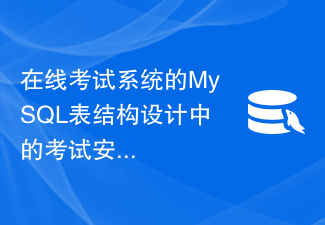 在线考试系统的MySQL表结构设计中的考试安排管理方法Oct 31, 2023 am 08:59 AM
在线考试系统的MySQL表结构设计中的考试安排管理方法Oct 31, 2023 am 08:59 AM在线考试系统的MySQL表结构设计中的考试安排管理方法随着互联网的普及和发展,在线考试系统成为了目前教育领域中广泛使用的一种教学和考试工具。而在线考试系统的MySQL表结构设计对于系统的稳定运行和考试安排管理起着至关重要的作用。本文将详细介绍在线考试系统的MySQL表结构设计中的考试安排管理方法,并提供具体的代码示例。一、需求分析在进行MySQL表结构设计之
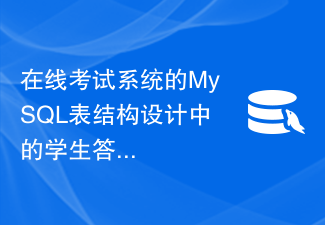 在线考试系统的MySQL表结构设计中的学生答题记录管理技巧Oct 31, 2023 am 09:39 AM
在线考试系统的MySQL表结构设计中的学生答题记录管理技巧Oct 31, 2023 am 09:39 AM在线考试系统的MySQL表结构设计中的学生答题记录管理技巧引言:随着网络技术的迅猛发展,许多教育机构和企事业单位开始采用在线考试系统来进行评估、考核和培训等相关工作。其中一个核心问题是如何设计合适的MySQL数据库表结构来管理学生的答题记录。本文将分享一些管理技巧,并提供具体的代码示例,帮助读者更好地理解这个设计过程。一、需求分析在设计MySQL表结构前,我
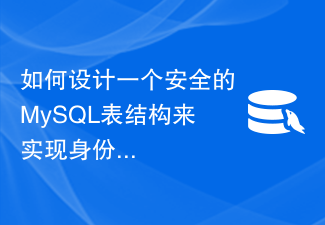 如何设计一个安全的MySQL表结构来实现身份验证功能?Oct 31, 2023 am 09:05 AM
如何设计一个安全的MySQL表结构来实现身份验证功能?Oct 31, 2023 am 09:05 AM如何设计一个安全的MySQL表结构来实现身份验证功能?在现代信息时代,身份验证是我们日常生活中不可或缺的一部分。无论是在网络上还是在实际生活中,我们都需要确保只有授权用户才能访问特定的资源或执行特定的操作。在数据库中实现身份验证功能是非常重要的一步,这样可以有效地保护数据的安全性。本文将介绍如何设计一个安全的MySQL表结构来实现身份验证功能,并提供相应的代
 如何设计一个可靠的MySQL表结构来实现文件存储功能?Oct 31, 2023 am 09:57 AM
如何设计一个可靠的MySQL表结构来实现文件存储功能?Oct 31, 2023 am 09:57 AM如何设计一个可靠的MySQL表结构来实现文件存储功能?目前,文件存储已经成为许多应用程序中不可或缺的一部分。在设计可靠的MySQL表结构时,我们需要考虑以下几个关键因素:文件存储方式文件存储可以采用两种方式:将文件直接存储在数据库中,或者将文件存储在磁盘上,并在数据库中存储文件的路径。直接将文件存储在数据库中的方式可以简化管理,但对于大型文件可能会影响数据库
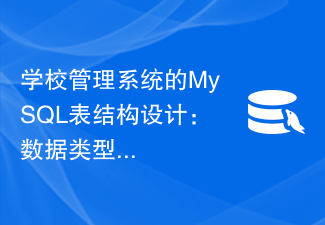 学校管理系统的MySQL表结构设计:数据类型选择指南Oct 31, 2023 am 09:15 AM
学校管理系统的MySQL表结构设计:数据类型选择指南Oct 31, 2023 am 09:15 AM学校管理系统的MySQL表结构设计:数据类型选择指南引言:在设计学校管理系统的数据库时,合理选择MySQL表的数据类型是非常重要的。正确选择数据类型可以保证数据库的性能优化和数据完整性。本文将提供一个指南,帮助你在设计学校管理系统的MySQL表时,选择正确的数据类型。除了介绍各种常用的数据类型外,我们还会提供具体的代码示例。一、整数类型整数类型主要用


Hot AI Tools

Undresser.AI Undress
AI-powered app for creating realistic nude photos

AI Clothes Remover
Online AI tool for removing clothes from photos.

Undress AI Tool
Undress images for free

Clothoff.io
AI clothes remover

AI Hentai Generator
Generate AI Hentai for free.

Hot Article

Hot Tools

Atom editor mac version download
The most popular open source editor

Dreamweaver Mac version
Visual web development tools

VSCode Windows 64-bit Download
A free and powerful IDE editor launched by Microsoft

SAP NetWeaver Server Adapter for Eclipse
Integrate Eclipse with SAP NetWeaver application server.

EditPlus Chinese cracked version
Small size, syntax highlighting, does not support code prompt function




